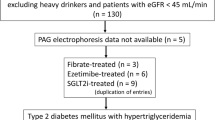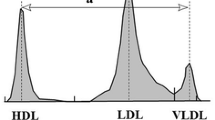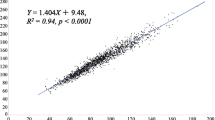Abstract
Hypertriglyceridemia, which often leads to both low-density lipoprotein (LDL) and high-density lipoprotein (HDL) metabolic disorders, is a strong risk factor for the development of atherosclerotic cardiovascular disease (ASCVD). We hypothesized that the triglyceride (TG)/HDL cholesterol (TG/HDL-C) ratio may be more useful for estimation of the LDL-particle size, as a well-known risk factor for ASCVD, as compared to the serum TG level per se. Polyacrylamide gel electrophoresis was used in this study to estimate the LDL-particle size [relative LDL migration (LDL-Rm value)] in 649 consecutive patients with one additional risk factor for ASCVD. Multivariable regression analysis identified both serum TG (β = 0.556, p < 0.0001) and the serum TG/HDL-C ratio (β = 0.607, p < 0.0001) as independent indicators of the LDL-particle size. In terms of evaluation of the accuracy of indicators of LDL-Rm values equal to or greater than 0.40, which are suggestive of the presence of large amounts of small-dense LDL and represent the upper limit (mean + 2 standard deviation) of the normal range in this population, both the serum TG level and serum TG/HDL-C ratio showed high accurate areas under the receiver-operating characteristic curve (0.900 vs. 0.914), but with a negative likelihood ratio of 0.506 vs. 0.039, indicating that the TG/HDL-C ratio model is superior for excluding patients with values below the cutoff value and with LDL-Rm values ≥ 0.40. Furthermore, in 456 patients followed up for at least 1 year, multivariable regression analysis identified increased serum TG/HDL-C ratio as an independent predictor of a decreased LDL-particle size. These results suggest that the serum TG/HDL-C ratio may be more useful for assessing the risk of ASCVD as compared to the serum TG level per se. To reduce the risk of ASCVD, it may be important to focus not only on changes of the serum LDL-C, but also on those of the serum TG/HDL-C ratio.





Similar content being viewed by others
References
Baigent C, Keech A, Kearney PM, Blackwell L, Buck G, Pollicino C, Kirby A, Sourjina T, Peto R, Collins R, Simes R, Cholesterol Treatment Trialists’ (CTT) Collaborators (2005) Efficacy and safety of cholesterol-lowering treatment: prospective meta-analysis of data from 90,056 participants in 14 randomised trials of statins. Lancet 366:1267–1278
Mihaylova B, Emberson J, Blackwell L, Keech A, Simes J, Barnes EH, Voysey M, Gray A, Collins R, Baigent C, Cholesterol Treatment Trialists’ (CTT) Collaborators (2012) The effects of lowering LDL cholesterol with statin therapy in people at low risk of vascular disease: meta-analysis of individual data from 27 randomised trials. Lancet 380:581–590
Cannon CP, Blazing MA, Giugliano RP, McCagg A, White JA, Theroux P, Darius H, Lewis BS, Ophuis TO, Jukema JW, De Ferrari GM, Ruzyllo W, De Lucca P, Im K, Bohula EA, Reist C, Wiviott SD, Tershakovec AM, Musliner TA, Braunwald E, Califf RM, IMPROVE-IT Investigators (2015) Ezetimibe added to statin therapy after acute coronary syndromes. N Engl J Med 372:2387–2397
Bohula EA, Giugliano RP, Leiter LA, Verma S, Park JG, Sever PS, Pineda AL, Honarpour N, Wang H, Murphy SA, Keech A, Pedersen TR, Sabatine MS (2018) Inflammatory and cholesterol risk in the FOURIER Trial (further cardiovascular outcomes research with PCSK9 inhibition in patients with elevated risk). Circulation. https://doi.org/10.1161/CIRCULATIONAHA.118.034032
Miller M, Stone NJ, Ballantyne C, Bittner V, Criqui MH, Ginsberg HN, Goldberg AC, Howard WJ, Jacobson MS, Kris-Etherton PM, Lennie TA, Levi M, Mazzone T, Pennathur S (2011) American Heart Association Clinical Lipidology, Thrombosis, and Prevention Committee of the Council on Nutrition, Physical Activity, and Metabolism; Council on Arteriosclerosis, Thrombosis and Vascular Biology; Council on Cardiovascular Nursing; Council on the Kidney in Cardiovascular Disease. Triglycerides and cardiovascular disease: a scientific statement from the American Heart Association. Circulation 123:2292–2333
Ip CK, Jin DM, Gao JJ, Meng Z, Meng J, Tan Z, Wang JF, Geng DF (2015) Effects of add-on lipid-modifying therapy on top of background statin treatment on major cardiovascular events: a meta-analysis of randomized controlled trials. Int J Cardiol 191:138–148
Bittner V, Johnson BD, Zineh I, Rogers WJ, Vido D, Marroquin OC, Bairey-Merz CN, Sopko G (2009) The triglyceride/high-density lipoprotein cholesterol ratio predicts all-cause mortality in women with suspected myocardial ischemia: a report from the Women’s Ischemia Syndrome Evaluation (WISE). Am Heart J 157:548–555
Wan K, Zhao J, Huang H, Zhang Q, Chen X, Zeng Z, Zhang L, Chen Y (2015) The association between triglyceride/high-density lipoprotein cholesterol ratio and all-cause mortality in acute coronary syndrome after coronary revascularization. PLoS ONE 10(4):e0123521
Hirano T, Ito Y, Yoshino G (2005) Measurement of small dense low-density lipoprotein particles. J Atheroscler Thromb 12:67–72
Tani S, Matsumoto M, Nagao K, Hirayama A (2014) Association of triglyceride-rich lipoproteins-related markers and low-density lipoprotein heterogeneity with cardiovascular risk: effectiveness of polyacrylamide-gel electrophoresis as a method of determining low-density lipoprotein particle size. J Cardiol 63:60–68
Tani S, Takahashi A, Nagao K, Hirayama A (2015) Effect of dipeptidyl peptidase-4 inhibitor, vildagliptin on plasminogen activator inhibitor-1 in patients with diabetes mellitus. Am J Cardiol 115:454–460
Imai E, Horio M, Nitta K, Yamagata K, Iseki K, Hara S, Ura N, Kiyohara Y, Hirakata H, Watanabe T, Moriyama T, Ando Y, Inaguma D, Narita I, Iso H, Wakai K, Yasuda Y, Tsukamoto Y, Ito S, Makino H, Hishida A, Matsuo S (2007) Estimation of glomerular filtration rate by the MDRD study equation modified for Japanese patients with chronic kidney disease. Clin Exp Nephrol 11:41–50
Sniderman AD, Blank D, Zakarian R, Bergeron J, Frohlich J (2003) Triglycerides and small dense LDL: the twin Achilles heels of the Friedewald formula. Clin Biochem 36:499–504
Nakano T, Inoue I, Seo M, Takahashi S, Awata T, Komoda T, Katayama S (2009) Rapid and simple profiling of lipoproteins by polyacrylamide-gel disc electrophoresis to determine the heterogeneity of low-density lipoproteins (LDLs) including small, dense LDL. Recent Pat Cardiovasc Drug Discov 4:31–36
Yoshino G, Hirano T, Kazumi T (2002) Treatment of small dense LDL. J Atheroscler Thromb 9:266–275
Tani S, Nagao K, Matsumoto M, Hirayama A (2013) Highly purified eicosapentaenoic acid may increase low-density lipoprotein particle size by improving triglyceride metabolism in patients with hypertriglyceridemia. Circ J 77:2349–2357
Tani S, Matsuo R, Kawauchi K, Yagi T, Atsumi W, Hirayama A (2018) A cross-sectional and longitudinal study between association of n-3 polyunsaturated fatty acids derived from fish consumption and high-density lipoprotein heterogeneity. Heart Vessels 33:470–480
Tani S, Takahashi A, Nagao K, Hirayama A (2016) Association of lecithin-cholesterol acyltransferase activity measured as a serum cholesterol esterification rate and low-density lipoprotein heterogeneity with cardiovascular risk: a cross-sectional study. Heart Vessels 31:831–840
Grimes DA, Schulz KF (2005) Refining clinical diagnosis with likelihood ratios. Lancet 365:1500–1505
Davidson M (2002) The interpretation of diagnostic test: a primer for physiotherapists. Aust J Physiother 48:227–232
McLaughlin T, Reaven G, Abbasi F, Lamendola C, Saad M, Waters D, Simon J, Krauss RM (2005) Is there a simple way to identify insulin-resistant individuals at increased risk of cardiovascular disease? Am J Cardiol 96:399–404
Salazar MR, Carbajal HA, Espeche WG, Leiva Sisnieguez CE, Balbín E, Dulbecco CA, Aizpurúa M, Marillet AG, Reaven GM (2012) Relation among the plasma triglyceride/high-density lipoprotein cholesterol concentration ratio, insulin resistance, and associated cardio-metabolic risk factors in men and women. Am J Cardiol 109:1749–1753
Salazar MR, Carbajal HA, Espeche WG, Aizpurúa M, Maciel PM, Reaven GM (2014) Identification of cardiometabolic risk: visceral adiposity index versus triglyceride/HDL cholesterol ratio. Am J Med 127:152–157
Quispe R, Manalac RJ, Faridi KF, Blaha MJ, Toth PP, Kulkarni KR, Nasir K, Virani SS, Banach M, Blumenthal RS, Martin SS, Jones SR (2015) Relationship of the triglyceride to high-density lipoprotein cholesterol (TG/HDL-C) ratio to the remainder of the lipid profile: the very large database of lipids-4 (VLDL-4) study. Atherosclerosis 242:243–250
TG and HDL Working Group of the Exome Sequencing Project, National Heart, Lung, and Blood Institute, Crosby J, Peloso GM, Auer PL, Crosslin DR, Stitziel NO, Lange LA, Lu Y, Tang ZZ, Zhang H, Hindy G, Masca N, Stirrups K, Kanoni S, Do R, Jun G, Hu Y, Kang HM, Xue C, Goel A, Farrall M, Duga S, Merlini PA, Asselta R, Girelli D, Olivieri O, Martinelli N, Yin W, Reilly D, Speliotes E, Fox CS, Hveem K, Holmen OL, Nikpay M, Farlow DN, Assimes TL, Franceschini N, Robinson J, North KE, Martin LW, DePristo M, Gupta N, Escher SA, Jansson JH, Van Zuydam N, Palmer CN, Wareham N, Koch W, Meitinger T, Peters A, Lieb W, Erbel R, Konig IR, Kruppa J, Degenhardt F, Gottesman O, Bottinger EP, O’Donnell CJ, Psaty BM, Ballantyne CM, Abecasis G, Ordovas JM, Melander O, Watkins H, Orho-Melander M, Ardissino D, Loos RJ, McPherson R, Willer CJ, Erdmann J, Hall AS, Samani NJ, Deloukas P, Schunkert H, Wilson JG, Kooperberg C, Rich SS, Tracy RP, Lin DY, Altshuler D, Gabriel S, Nickerson DA, Jarvik GP, Cupples LA, Reiner AP, Boerwinkle E (2014) Kathiresan S (2014) Loss-of-function mutations in APOC3, triglycerides, and coronary disease. N Engl J Med. 71:22–31
Kondo A, Li J, Manabe M, Saito K, Kanno T, Maekawa M (2003) Relationship between high-density lipoprotein-cholesterol and malondialdehyde-modified low-density lipoprotein concentrations. J Atheroscler Thromb 10:72–78
Shah PK, Kaul S, Nilsson J, Cercek B (2001) Exploiting the vascular protective effects of high-density lipoprotein and its apolipoproteins: an idea whose time for testing is coming, part I. Circulation 104:2376–2383
Oda E (2013) High-sensitivity C-reactive protein and white blood cell count equally predict development of the metabolic syndrome in a Japanese health screening population. Acta Diabetol 50:633–638
Madjid M, Awan I, Willerson JT, Casscells SW (2004) Leukocyte count and coronary heart disease: implications for risk assessment. J Am Coll Cardiol 44:1945–1956
Maruyama C, Imamura K, Teramoto T (2003) Assessment of LDL particle size by triglyceride/HDL-cholesterol ratio in non-diabetic, healthy subjects without prominent hyperlipidemia. J Atheroscler Thromb 10:186–191
Kiyosue A (2018) Nonfasting TG/HDL-C ratio seems a good predictor of MACE in CAD patients with statin therapy. Could it be a treatment target? J Cardiol 71:8–9
Pemafibrate to reduce cardiovascular OutcoMes by reducing triglycerides IN patiENts With diabeTes (PROMINENT) (ClinicalTrials.gov Identifier: NCT03071692
Cuschieri S, Vassallo J, Calleja N, Pace N, Mamo J (2017) The effect of age, gender, TG/HDL-C ratio and behavioral lifestyles on the metabolic syndrome in the high risk Mediterranean Island population of Malta. Diabetes Metab Syndr. Suppl 1:S321–S327
Murguía-Romero M, Jiménez-Flores JR, Sigrist-Flores SC, Espinoza-Camacho MA, Jiménez-Morales M, Piña E, Méndez-Cruz AR, Villalobos-Molina R, Reaven GM (2013) Plasma triglyceride/HDL-cholesterol ratio, insulin resistance, and cardiometabolic risk in young adults. J Lipid Res 54:2795–2799
Acknowledgements
The authors would like to thank International Medical Information Center (www.imic.or.jp/services/translation.html) for the English language review, and Dr. Yasuyuki Suzuki for helpful statistical analysis. The authors would also like to thank Mr. Gary Cooper for his help in editing the English manuscript.
Funding
No funding was obtained for this study
Author information
Authors and Affiliations
Corresponding author
Ethics declarations
Conflict of interest
The author declares that he/she has no competing interests.
Additional information
Clinical Trial Registration: UMIN (http://www.umin.ac.jp/) Study ID: UMIN000032934 retrospectively registered 11 Jun 2017.
Rights and permissions
About this article
Cite this article
Yokoyama, K., Tani, S., Matsuo, R. et al. Increased triglyceride/high-density lipoprotein cholesterol ratio may be associated with reduction in the low-density lipoprotein particle size: assessment of atherosclerotic cardiovascular disease risk. Heart Vessels 34, 227–236 (2019). https://doi.org/10.1007/s00380-018-1247-9
Received:
Accepted:
Published:
Issue Date:
DOI: https://doi.org/10.1007/s00380-018-1247-9




